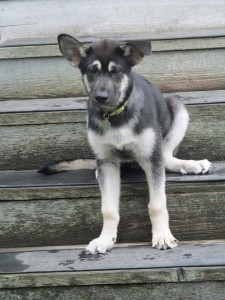
Walking With A Loose Leash
You walk your dog every day, or every day you can.
You walk your dog for exercise, for both of you.
You walk your dog because you enjoy the time with him.
The walk may be your only one-on-one time with your dog every day, except when you are both asleep. Even if you walk with friends or family, when your dog’s leash is in your hand, you and the dog are in it together. The walk can be its own reward—but imagine what you could accomplish if you taught your dog some important skills every time you took a walk together?
What can you teach your dog when you walk him?
Walking with a loose leash.
How do you teach it?
Dogs pull on leashes because they want to get somewhere. On a walk, it’s often to the next tree to have a good sniff, to chase after that squirrel, or to turn and run when a scary big truck drives by. Dogs want to go where dogs want to go.
What’s your job?
Don’t let them.
- Your dog should be wearing a well-fitted harness or a snug-fitting buckle collar that can’t slip off.
- The leash should be comfortable for you to hold in your hands.
- Your behavior should be enormously patient during this lesson.
- You should also be physically able to withstand the pulling strength of your dog.
- Put your dog on leash and take a step out your front door.
- If the dog pulls—at all—stand absolutely still. Say nothing. Do nothing until there is a slight slackness in the leash.
These first steps will be the hardest because you might become discouraged. Yes, it is possible that your first few attempts will result in no walk. The leash may stay tight. If the leash stays tight for longer than you or the dog can physically stand it, take the dog back inside, take the leash off, do something else, and try again later.
If the dog must be walked to potty, try starting this lesson on a walk after the dog has eliminated, instead of at the beginning of the walk. If the dog must be walked for exercise, teach this lesson during only part of the walk.
- The second the leash becomes slack, take a step forward.
Look for even a tiny increment of loosening in the leash resulting from the dog’s slight change of position. It doesn’t matter what the dog is doing (as long as you are not being injured), it matters only that the leash is slack.
Slackness in the leash results in your moving forward—that is what the dog wants, a chance to get walking. You reward the dog for slackness in the leash by moving forward so that he can move forward, too. You get what you want, he gets what he wants.
- Repeat.
- Endlessly.

How long will it take before your dog stops pulling?
That depends partly on his past experience.
How long has he been pulling on the leash?
It might take that long for him to learn not to pull.
Which means that your best return on investment with this lesson comes from teaching it to your puppy the first time you take him out for a walk. Conversely, if you’re teaching this lesson to a dog who’s been pulling all his life, every day, every walk, and he’s ten years old … you see what I mean?
- Your goal is to teach your dog that pulling on the leash is not rewarding.
- Pulling on the leash does not result in movement in the direction the dog wants to move.
- Pulling on the leash means going nowhere.
If he learns that lesson well, your dog will have accomplished something many pet dogs never achieve, walking on a loose leash. That is a skill of which you can be very proud.
Should you teach this lesson for the whole walk?
That’s up to you! It’s your dog and your choice.
You’re not teaching a “command” for this behavior, you’re teaching a default. When owner stops and stands still, dog stops and stands still—no straining at the leash. You don’t say a single word.
Keep it simple. Food rewards, toys, cue words—none of these are really necessary. It’s just you, your dog, a leash, and a collar or harness. He pulls, you stop. The leash loosens even slightly, you go.
Give it a try!
NEXT WEEK: What Can I Teach My Dog On A Walk? Coming When Called



